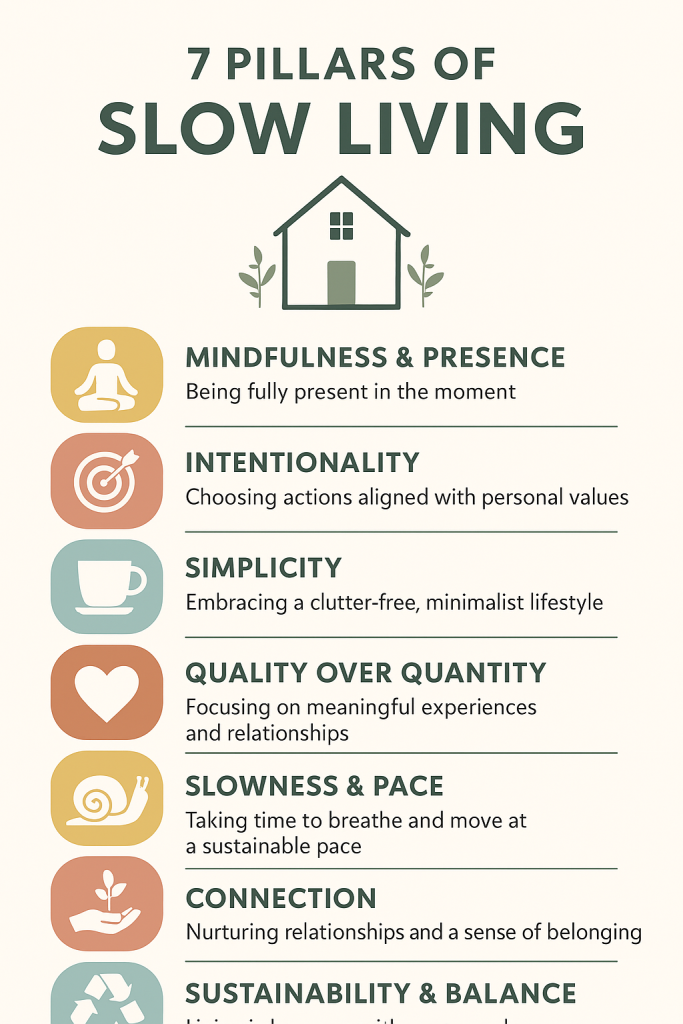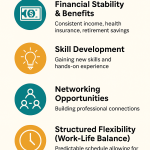Introduction
In today’s hyper-connected, fast-paced culture, the idea of slowing down can feel counterintuitive—almost rebellious. Yet, as burnout, stress, and digital overwhelm become more widespread, many people are rediscovering the ancient wisdom of slow living. Far from laziness or idleness, slow living is about living intentionally—choosing quality over quantity, mindfulness over mindlessness, and presence over distraction.
In this ultimate guide—stretching over 10,000 words—you’ll find not just a conceptual framework but a practical roadmap to integrate slow living into your daily life. We’ll explore the 10 pillars of slow living, weaving in actionable tips, research, real-life examples, and insights from sustainability, psychology, and lifestyle design. Whether you’re curious about minimalism, searching for balance, or longing for a deeper connection with yourself and others, this guide is your starting point.
Pillar 1: Mindfulness and Presence
Why It Matters
Mindfulness is the foundation of slow living. Without awareness, life becomes a blur of deadlines, notifications, and routines. Studies show that practicing mindfulness reduces stress, increases focus, and enhances overall well-being. Slow living begins by paying attention.
How to Practice
- Begin with short daily meditations (5–10 minutes).
- Incorporate mindful rituals into meals: savor flavors, textures, and smells.
- Limit multitasking; do one task at a time with full attention.
- Create digital-free zones, like keeping phones away from the dining table.
Case Study
In a Harvard study, people who practiced mindfulness reported a 27% increase in life satisfaction within eight weeks. This demonstrates how presence can profoundly transform day-to-day living.
Pillar 2: Intentional Living
Why It Matters
Intentionality is about aligning actions with values. Without intention, it’s easy to chase other people’s definitions of success. Intentional living redirects focus toward what truly matters.
How to Practice
- Define 3–5 core values and revisit them monthly.
- Evaluate commitments—if they don’t serve your values, let them go.
- Practice conscious consumption: ask “Do I need this?” before purchasing.
Practical Example
If your value is family, schedule weekly family dinners without digital interruptions. This small act reinforces intentionality and creates meaningful memories.
Pillar 3: Simplicity
Why It Matters
Clutter—physical, mental, and digital—creates overwhelm. Simplicity allows room for clarity, creativity, and peace. Research on minimalism shows that reducing possessions correlates with reduced anxiety and increased happiness.
How to Practice
- Adopt the one-in, one-out rule for possessions.
- Declutter one area of your home weekly.
- Practice digital minimalism by unfollowing accounts that don’t inspire you.
Pro Tip
Start small. Declutter your desk, then expand to your closet, then your entire living space.
Pillar 4: Quality over Quantity
Why It Matters
Slow living shifts focus from accumulation to appreciation. A wardrobe with fewer, high-quality items often feels more satisfying than a cluttered closet of cheap, trendy purchases.
How to Practice
- Invest in durable, timeless clothing.
- Prioritize experiences—like travel, cooking, or explore hobbies here.
- Build fewer but deeper relationships.
Real-Life Example
The Danish concept of hygge exemplifies quality over quantity, emphasizing cozy, intimate experiences over excess. To learn more, check out this BBC guide to hygge culture.
Pillar 5: A Gentle Pace
Why It Matters
Rushing from task to task leads to exhaustion. A slower pace promotes focus, creativity, and joy. Neuroscience shows that breaks improve memory consolidation and cognitive performance.
How to Practice
- Schedule buffer time between meetings.
- Embrace “slow food”—cook meals from scratch and enjoy them leisurely.
- Practice time blocking to reduce frantic multitasking.
Practical Example
Instead of cramming errands in one chaotic day, spread them across the week. The slower pace reduces stress and allows for more mindful living.
Pillar 6: Connection—to Self, Others, and Nature
Why It Matters
Human beings thrive on connection. Slow living emphasizes meaningful bonds—with yourself, with loved ones, and with the natural world.
How to Practice
- Journal daily to reflect on emotions and goals.
- Spend at least 30 minutes outdoors each day.
- Create traditions that foster deeper family or community ties.
Pro Tip
Forest bathing, a Japanese practice, has been proven to reduce stress hormones and increase immune function. Learn more about this practice in this National Geographic article on forest bathing.
Pillar 7: Sustainability and Balance
Why It Matters
Slow living naturally aligns with sustainability. By consuming less and valuing longevity, you reduce waste and environmental strain. Balance, meanwhile, ensures you don’t burn out.
How to Practice
- Opt for eco-friendly alternatives—reusable bags, water bottles, bamboo products.
- Create boundaries for work (no emails after dinner).
- Balance productivity with restorative practices like yoga or reading.
Pro Tip
For deeper insights, explore this UN guide to sustainable living.
Pillar 8: Creativity and Curiosity
Why It Matters
When you slow down, space opens for creativity. A slower life nurtures curiosity and exploration—qualities often drowned out by busyness.
How to Practice
- Dedicate weekly time for hobbies like painting, writing, or cooking.
- Limit passive consumption (like scrolling) and replace it with creative output.
- Explore new interests without pressure for perfection.
Research Insight
Studies show that unstructured time fuels divergent thinking, the foundation of creativity.
Pillar 9: Rest and Renewal
Why It Matters
Rest is not laziness—it is essential. Sleep, relaxation, and downtime fuel productivity and joy. Slow living redefines rest as an intentional practice, not a guilty pleasure.
How to Practice
- Prioritize 7–8 hours of sleep nightly.
- Schedule downtime like you would any meeting.
- Try restorative practices: yoga nidra, deep breathing, or naps.
Real-Life Example
Companies in Sweden experimenting with 6-hour workdays report higher productivity and improved employee well-being. Read more in this Guardian article on shorter workdays.
Pillar 10: Gratitude and Contentment
Why It Matters
Gratitude shifts focus from what’s missing to what’s present. Contentment helps resist consumerist pressure for “more” and instead embraces sufficiency.
How to Practice
- Keep a gratitude journal—list 3 things daily.
- Share appreciation verbally with loved ones.
- Reflect weekly on how far you’ve come instead of what’s lacking.
Pro Tip
Research shows gratitude practices reduce depression and increase happiness by up to 25%. For further reading, check out this Psychology Today article on gratitude.
Conclusion: The Art of Living Slowly
Slow living is not a rigid set of rules—it’s a mindset, a way of reimagining how we engage with time, people, and the world. By integrating these 10 pillars—mindfulness, intentionality, simplicity, quality, pace, connection, sustainability, creativity, rest, and gratitude—you create a lifestyle that emphasizes depth over speed.
In a culture obsessed with more, slow living reminds us that less can be profoundly fulfilling. You don’t need to overhaul your life overnight. Start small—choose one pillar this week, and gradually, your days will align more with what truly matters.
✅ Practical Takeaway: The journey to slow living begins with awareness. Pause, breathe, and ask yourself: Am I living the life I want, or the life I’ve been told to chase? Your answer will guide the pace of your transformation.



